5G Network Architecture: Being Built Like Lego Blocks
China is now in the 3G and 4G and will be in the 5G era by 2020. 5G implies the interconnection of everything in a digital world, which includes man-to-man, man-to-machine, and machine-to-machine communications. 5G expects to not only introduce stretched network performance, such as 10 giga bps throughput, 1 ms delay and over 1 million connections, but have in-depth convergence with diverse vertical industries to enable abundant applications, such as high-speed railway, intelligent car, remote telecom-operation, virtual reality, and augmented reality.
In the 5G era, many use cases and customer-oriented businesses will be supported. A 5G network will be quickly set up and modified and have higher performance. This will be a big challenge for legacy mobile network architecture. A legacy network is function oriented, so dedicated hardware is used for RAN and core, and the processing of CS and PS is separate. However, a 5G network will be a unified, service-oriented, flexible telecom platform that can support an abundance of applications like IOS or Android in smart phones. The top of the platform enables diverse applications through simple development and adaption.
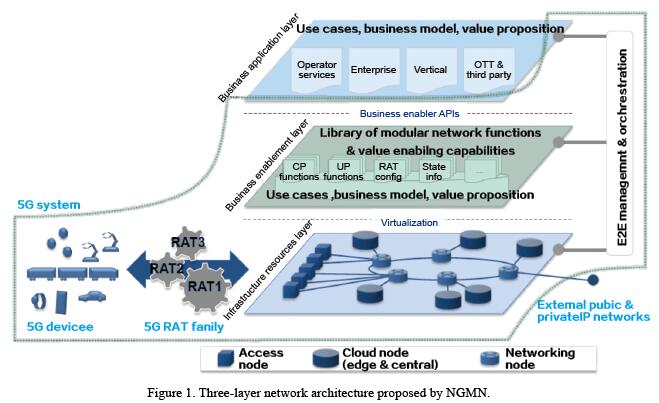
The three-layer network architecture proposed by NGMN has been accepted in the telecom industry. At the bottom of the architecture is the infrastructure resource layer that includes access nodes, cloud nodes and networking nodes (Fig. 1). This layer virtualizes physical resources. In the middle of the architecture is the business enablement layer, which provides common information repository and a library of network functions such as control plan, user plan, state information, and RAT configuration. On the top of the architecture is the business application layer, which can deliver a variety of services to operators, enterprises and even OTT and third parties. These three layers can be managed end to end and can be dynamically orchestrated by the management and orchestration part.
ZTE's 5G network architecture is consistent with NGMN’s initiative. The future 5G network will be a software-defined network that includes three plus one key characteristics (Fig. 2).
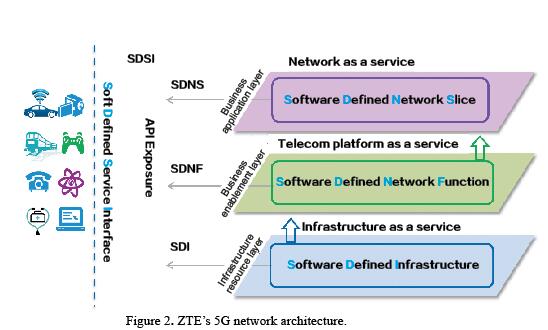
Software-defined infrastructure (SDI) corresponds to the infrastructure resource layer of NGMN. Legacy hardware elements such as RAN and core are redefined. All other hardware resources except dedicated hardware including accelerators are virtualized. These resources are uniformly managed and scheduled so that on-demand virtual resources can be provided to the upper layer. The SDI concept is similar to infrastructure as a service (IaaS) of an IT system. The infrastructure resource layer is separated into physical domain and virtualization domain (Fig. 3). The physical domain provides physical resource nodes, including the access node, computing node, networking node, and storage node. On top of the physical resource nodes is a virtualization layer that can provide virtualized resources to the upper layers through tools OpenStack. The virtual infrastructure management (VIM) on the right side manages resources in a unified way and provides IaaS interfaces. VIM also manages dedicated hardware to enhance telecom service performance such as user data forwarding, encryption, and decryption.
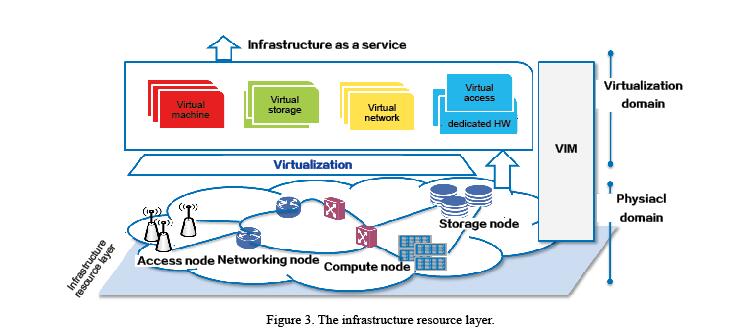
Software-defined network function (SDNF) is the business enablement layer of NGMN and can provide common functions and business components. The SDNF concept is similar to platform as a service (PaaS) of an IT system. An execution environment is needed for telecom cloud. Common services such as communication, load balancing, monitoring, and database are embedded in the execution environment (Fig. 4). On top of these services, a network function blueprint repository is provided. The network function blueprint is a description file that describes how components are composed in order to form a network function. The network function blueprint does not really work in the data center but is just a configuration to describe how components are orchestrated, similar to an application in the application store. The management system assembles and orchestrates these components, involving service topology management, orchestration management, and service lifecycle management. It functions as a manufactory where a finished product—network function is made.
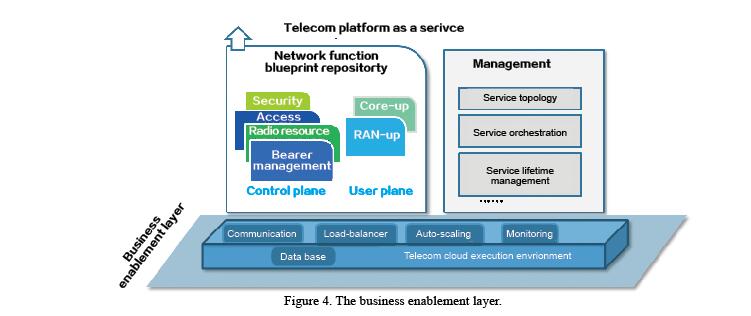
Software-defined network slice (SDNS) corresponds to the business application layer of NGMN. SDNS can provide different network slices to meet application requirements. Similar to network a function blueprint, a slice blueprint is also a description file that composes a number of network functions for end-to-end applications. An instance is a slice instance. These instances are real running programs that can implement specific applications, such as games downloaded from the application store running on smart phones.
The small hexagonal block in Fig. 5 is a network function. Blocks 1, 3 and 4 are used in both slice blueprints A and B, but their properties are different. Block 1 is shared network function and is also called multiple instances. Blocks 3 and 4 have a different copy in terms of instance. The shared block 1 means there may be a dedicated hardware that cannot be split, or there is the same virtual resource to be used such as an air interface. Blocks 1, 2, 3 and 4 comprise a slice blueprint A, and blocks 1, 5, 6, 3 and 4 form a slice blueprint B. The blueprints can be predefined by equipment vendors and be orchestrated by operators or OTTs.
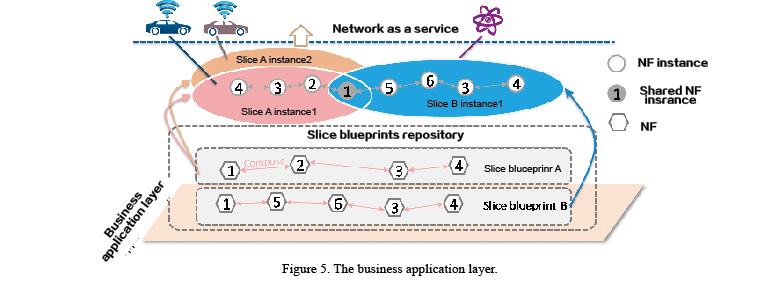
The red, blue and yellow ellipses indicate the slices after instantiation. These slices are programs that actually run in the network. The red and yellow ones are instantiated by the slice blueprint A and provide the same type of applications for different users, such as V2V to different vehicle companies. The blue one is instantiated by the slice blueprint B and can provide another type of service such as IOT.
Software-defined service interface (SDSI) provides open application program interfaces such as IaaS, PaaS and NaaS interfaces, as well as some user data and operating data. All this data can be delivered to a variety of vertical industries.
Based on the three-layer network architecture, a new functional module or a specific slice can be created without affecting other existing modules or slices. ZTE’s brand new 5G architecture is built on virtual, componentized, independent modules, like Lego building blocks, and can be flexibly adapted to various businesses and industries to meet challenges of the new era.